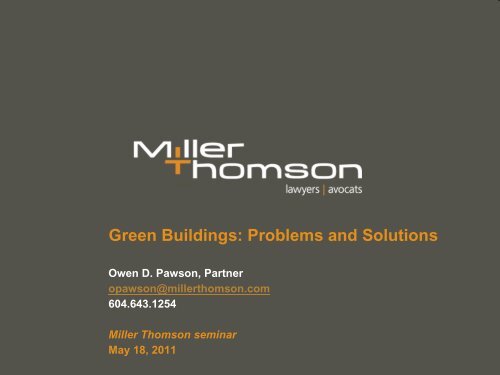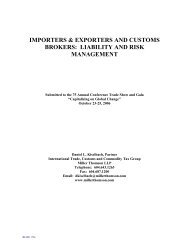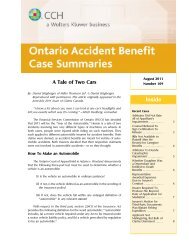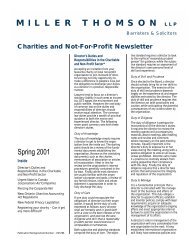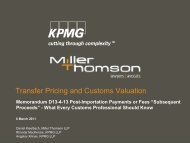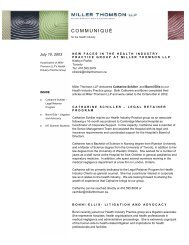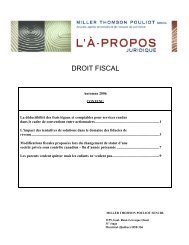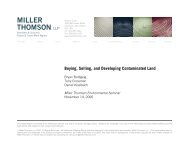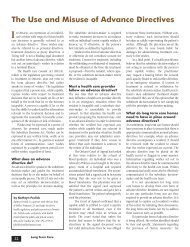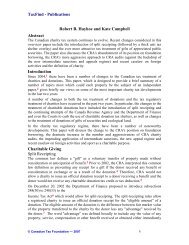Green Buildings - Problems, Solutions & Opportunities
Green Buildings - Problems, Solutions & Opportunities
Green Buildings - Problems, Solutions & Opportunities
You also want an ePaper? Increase the reach of your titles
YUMPU automatically turns print PDFs into web optimized ePapers that Google loves.
<strong>Green</strong> <strong>Buildings</strong>: <strong>Problems</strong> and <strong>Solutions</strong><br />
Owen D. Pawson, Partner<br />
opawson@millerthomson.com<br />
604.643.1254<br />
Miller Thomson seminar<br />
May 18, 2011
Building “<strong>Green</strong>”<br />
<strong>Green</strong> <strong>Buildings</strong><br />
TOPIC:<br />
Drafting and Negotiating Design Agreements<br />
and Construction Contracts for<br />
Sustainable <strong>Buildings</strong>
<strong>Green</strong> <strong>Buildings</strong><br />
“NO LONGER A FAD, GREEN HITS MAINSTREAM . . .”<br />
• ENR Magazine
<strong>Green</strong> <strong>Buildings</strong><br />
“<strong>Green</strong> Building for several years had been a novelty, an<br />
extra, sometimes expensive, set of bells and whistles to<br />
hang on signature buildings. But over the past two or<br />
three years, concerns about the environment and global<br />
warming have brought sustainable design to the forefront<br />
of the construction industry. And with the proliferation of<br />
green products and materials, and sudden surge in<br />
energy prices, building green no longer is an expensive<br />
luxury, but an often cost-effective alternative to traditional<br />
design.”<br />
- ENR Magazine; June 28, 2008
<strong>Green</strong> <strong>Buildings</strong><br />
Why Build “<strong>Green</strong>”?<br />
Because “Built Environment” is major source of:<br />
– CO2 (<strong>Green</strong>house Gas) Emissions<br />
– Energy and Water Consumption<br />
– Conventional Water and Air Pollution<br />
– Solid Waste Stream
<strong>Green</strong> <strong>Buildings</strong><br />
Impact of <strong>Buildings</strong> on Natural Resources<br />
<strong>Green</strong> <strong>Buildings</strong> create opportunities for big<br />
reductions - because buildings account for:<br />
• 39% of total energy use<br />
• 72% of electricity consumption<br />
• 38% of CO2 emissions<br />
• 40% of raw materials use<br />
• 12% waste output<br />
• 30% of potable water consumption
<strong>Green</strong> <strong>Buildings</strong><br />
Average Reductions by<br />
“<strong>Green</strong>” <strong>Buildings</strong><br />
– Energy Use - 30%<br />
– CO2 Emissions - 35%<br />
– Water Use - 30% - 50%<br />
– Waste Creation - 50% - 90%
<strong>Green</strong> <strong>Buildings</strong><br />
What is a “<strong>Green</strong> Building”?<br />
• No universally accepted definition of “<strong>Green</strong><br />
Building”<br />
• Therefore (for contracting drafting) term is<br />
ambiguous:<br />
– UNLESS it is tied to an objective standard<br />
• Currently, the most common indicia of a<br />
“<strong>Green</strong>” building is LEED certification
<strong>Green</strong> <strong>Buildings</strong><br />
LEED =<br />
Leadership in Energy and<br />
Environmental Design<br />
• most widely recognized <strong>Green</strong> Building rating<br />
system<br />
• recognized benchmark for design, construction<br />
and operation of high performance <strong>Green</strong><br />
<strong>Buildings</strong>
<strong>Green</strong> <strong>Buildings</strong><br />
– LEED - developed by U.S. <strong>Green</strong> Building<br />
Council (USGBC) in late 1990’s<br />
– Continually being refined through dialogue<br />
with multiple construction industry parties
<strong>Green</strong> <strong>Buildings</strong><br />
LEED Rating Systems are:<br />
–Voluntary<br />
– Consensus-based<br />
– Market-driven<br />
– Based on accepted energy and<br />
environmental principles<br />
– Balanced between established construction<br />
industry practices and emerging ideas
<strong>Green</strong> <strong>Buildings</strong><br />
Purpose of LEED Rating System:<br />
Promote sustainability in the built environment<br />
by:<br />
- establishing consistent, credible standards<br />
for what constitutes a “<strong>Green</strong>” building
LEED has Ratings Systems for different<br />
types of buildings:<br />
<strong>Green</strong> <strong>Buildings</strong><br />
– New construction and major renovations<br />
– Commercial interiors<br />
– Existing buildings<br />
– Core and shell<br />
–Homes
<strong>Green</strong> <strong>Buildings</strong><br />
What is LEED Certification?<br />
• Register building with Canadian <strong>Green</strong> Building<br />
Council (CaGBC), then project team prepares<br />
documentation and calculations to satisfy LEED<br />
design and construction requirements<br />
• “LEED Certified” Building must get min. number<br />
of ‘points’ under applicable LEED Rating System<br />
• To earn Certification, building must meet certain<br />
benchmarks within specified categories
<strong>Green</strong> <strong>Buildings</strong><br />
LEED Certification<br />
• At completion of construction, registered LEED<br />
<strong>Buildings</strong> can be awarded 1 of 4 designations<br />
based on number of points earned:<br />
Certified<br />
Silver<br />
Gold<br />
Platinum<br />
<strong>Green</strong><br />
<strong>Green</strong>er<br />
More <strong>Green</strong><br />
Most <strong>Green</strong>
<strong>Green</strong> <strong>Buildings</strong><br />
LEED Certification<br />
In Canada, LEED Canada NC-1.0 is derivative of<br />
USGBC’s LEED System<br />
- LEED Canada NC-1.0 (and companion LEED<br />
Canada Reference Guide):<br />
- intended to facilitate use of LEED <strong>Green</strong> Building<br />
Rating System
<strong>Green</strong> <strong>Buildings</strong><br />
Contracting for <strong>Green</strong> <strong>Buildings</strong><br />
Implementing “The <strong>Green</strong> Building Revolution”<br />
requires:<br />
- careful planning<br />
- design agreements and construction contracts that<br />
address <strong>Green</strong> Building issues
<strong>Green</strong> <strong>Buildings</strong><br />
Guidelines for <strong>Green</strong> Building Agreements/<br />
Contracts<br />
<strong>Green</strong> Building LEED clauses should ALSO address<br />
involvement by:<br />
-sub-consultants,<br />
-sub-trades and<br />
-suppliers<br />
Standard Industry Contracts need modification, e.g.:<br />
•RAIC 6 – Client-Architect Agreement (long form)<br />
•RAIC 7 – Client-Architect Agreement (short form)<br />
•ACEC 31 – Engineer/Client Agreement<br />
•CCDC 2 – Owner-Contractor Agreement
<strong>Green</strong> <strong>Buildings</strong><br />
Guidelines for “<strong>Green</strong>ing”<br />
Design Agreements and<br />
Construction Contracts
Guideline No. 1:<br />
<strong>Green</strong> <strong>Buildings</strong><br />
Standard form agreements and contracts do not<br />
properly document a <strong>Green</strong> Building<br />
Therefore either:<br />
– modify existing standard form documents, or<br />
– develop customized documents to address <strong>Green</strong><br />
Building issues
Guideline No. 2:<br />
<strong>Green</strong> <strong>Buildings</strong><br />
• Clearly state Owner’s “<strong>Green</strong> Building” goals<br />
• Require objective standards<br />
– (e.g., LEED certification)<br />
• If appropriate, tie Owner’s “<strong>Green</strong> Building”<br />
goals to Project Schedule
Guideline No. 3:<br />
<strong>Green</strong> <strong>Buildings</strong><br />
Identify objective standard to measure<br />
achievement of <strong>Green</strong> Building goals:<br />
– LEED Certification is appropriate<br />
– construction documents should state level of LEED<br />
Certification desired<br />
– Even if LEED Certification is not required, LEED<br />
standards can be used to define Owner’s<br />
sustainability and environmental goals
<strong>Green</strong> <strong>Buildings</strong><br />
Scope of Architect’s Services and Work<br />
TASK<br />
1. Register Project with CaGBC<br />
2. Evaluate Feasibility of targeted LEED Certification level<br />
3. Develop LEED Certification Strategy<br />
4. Document Design & Construction process on LEED Requirements<br />
5. Seek Credit Interpretation Rulings (CIR’s) from CaGBC<br />
6. Coordinate with CaGBC for Design & Construction Phase Reviews<br />
7. Assist Owner evaluate <strong>Green</strong> Bldg credentials of potential contractors<br />
8. Coordinate/facilitate the <strong>Green</strong> Building process<br />
LEED-<br />
Certified<br />
Project<br />
Yes<br />
Yes<br />
Yes<br />
Yes<br />
Yes<br />
Yes<br />
Yes<br />
Yes<br />
Uncertified<br />
Project<br />
No<br />
No<br />
No<br />
Yes<br />
No<br />
No<br />
Yes<br />
Yes
<strong>Green</strong> <strong>Buildings</strong><br />
Guideline No. 4:<br />
Engage a competent / experienced <strong>Green</strong><br />
Building Team; coordinate “<strong>Green</strong>” provisions<br />
into contracts of Team members<br />
Building ‘<strong>Green</strong>’ involves design AND<br />
construction, so - address <strong>Green</strong> Building issues<br />
in each contract, e.g.:<br />
–Owner / Architect; or Engineer / Client<br />
–Owner / Contractor
<strong>Green</strong> <strong>Buildings</strong><br />
<strong>Green</strong> Building Team Contractual Configuration<br />
Owner<br />
LEED Consultant<br />
Architect<br />
(LEED AP)<br />
Contractor<br />
(LEED AP)<br />
Civil<br />
Engineer<br />
MEP<br />
Engineer<br />
Interior<br />
Designer<br />
Subcontractor Subcontractor Subcontractor<br />
(LEED AP)<br />
(LEED AP)<br />
(LEED AP)
<strong>Green</strong> <strong>Buildings</strong><br />
Guideline No. 4: (con’t)<br />
• LEED AP for each <strong>Green</strong> Building Team<br />
member should be “Key Employee” under that<br />
agreement / contract<br />
• Anticipate any issues created by introducing<br />
independent LEED Consultant<br />
• Contractually oblige all <strong>Green</strong> Building Team<br />
members to cooperate / coordinate
Guideline No. 5:<br />
<strong>Green</strong> <strong>Buildings</strong><br />
An experienced <strong>Green</strong> Building Team facilitates<br />
collaboration<br />
- Consider requiring early use of Building Information<br />
Modeling (BIM) technology and/or collaborative<br />
contracting methods<br />
- BUT ensure its use is addressed in relevant<br />
agreements and contracts
<strong>Green</strong> <strong>Buildings</strong><br />
Allocating LEED Certification Risks<br />
Potential Risks for failing to achieve<br />
LEED Certification:<br />
– Inability to Benefit from Special Regulations<br />
– Loss of Expedited Permitting <strong>Opportunities</strong><br />
– Loss of Increased Density or other Zoning Incentives<br />
– Detrimental Impact on Project Financing<br />
– Damage to Branding <strong>Opportunities</strong> or Reputation<br />
– Loss of Competitive Advantage
<strong>Green</strong> <strong>Buildings</strong><br />
Allocating LEED Certification Risks<br />
Types of Provisions<br />
- Specify LEED Certification level sought<br />
- Identify <strong>Green</strong> Building Team; make LEED AP’s “Key Employees”<br />
- Architect/Contractor reps about prior <strong>Green</strong> Building experience /<br />
expertise<br />
- Professional Services and Construction Work to be consistent with<br />
LEED requirements<br />
- Specify <strong>Green</strong> Building incentives that are essential for Owner<br />
- Use Performance-based remedies for failure to achieve LEED<br />
Certification<br />
- Consider creative ways to quantify Owner’s damages for failure to<br />
achieve <strong>Green</strong> Building certification
<strong>Green</strong> <strong>Buildings</strong>: Contract Issues<br />
Document LEED Certification level being<br />
sought by Owner<br />
Ensure clear provisions in design agreement and<br />
construction contract that:<br />
- Owner requires specific level of LEED Certification
<strong>Green</strong> <strong>Buildings</strong>: Contract Issues<br />
Confirm <strong>Green</strong> Building credentials of<br />
Architect and Contractor<br />
- Representation of experience with <strong>Green</strong> <strong>Buildings</strong><br />
Confirm participation of LEED AP’s on<br />
<strong>Green</strong> Building Team<br />
- Representation that there are experienced LEED<br />
personnel who will be “key employees”
<strong>Green</strong> <strong>Buildings</strong>: Contract Issues<br />
Document <strong>Green</strong> Building<br />
representations made by Architect or<br />
Contractor<br />
- such representations are material<br />
inducements for the Owner to engage the<br />
Architect or Contractor for the Project
<strong>Green</strong> <strong>Buildings</strong>: Contract Issues<br />
Require performance of design<br />
services in conformity with LEED<br />
requirements<br />
- Architect to develop plans and specs<br />
consistent with:<br />
- <strong>Green</strong> Building principles including LEED and<br />
- Owner’s goal of LEED certification<br />
- Architect to engage sub-consultants<br />
knowledgeable about <strong>Green</strong> Building principles
<strong>Green</strong> <strong>Buildings</strong>: Contract Issues<br />
Require performance of construction<br />
Work in conformity with LEED<br />
requirements<br />
- Contractor to perform Work in a manner<br />
consistent with<br />
- <strong>Green</strong> Building principles including LEED and<br />
- Owner’s goal of LEED certification<br />
- Contractor to engage sub-contractors<br />
knowledgeable about <strong>Green</strong> Building<br />
principles (subcontracts to have similar term)
<strong>Green</strong> <strong>Buildings</strong>: Contract Issues<br />
Establish performance-based remedies<br />
for actions that threaten LEED<br />
Certification<br />
- Designer to take all actions reasonably necessary to<br />
correct problem – including redesign at no cost to Owner<br />
- Contractor (and Subs) to take all actions reasonably<br />
necessary to correct problem - including replacing<br />
materials and equipment that do not meet LEED<br />
requirements and removing / redoing Work that does not<br />
meet LEED requirements (including warranty period)
<strong>Green</strong> <strong>Buildings</strong>: Contract Issues<br />
Assure continuation of Architect’s<br />
Services until LEED Certification<br />
- Obligation to provide design services<br />
continues until issuance of certification -<br />
includes any delay in issuance of certification<br />
or any denial due to Contractor (or any Sub)<br />
action / inaction (but services will be paid for)
<strong>Green</strong> <strong>Buildings</strong>: Contract Issues<br />
Assure continuation of Contractor’s<br />
Work until LEED Certification<br />
- Obligation to perform Work as per Contract<br />
Time and Contract Price continues until<br />
issuance of certification - includes any delay in<br />
issuance of certification or any denial due to<br />
Architect (or any Sub-consultant) action /<br />
inaction (but Change Order will adjust Contract<br />
Time and Contract Price)
<strong>Green</strong> <strong>Buildings</strong>: Contract Issues<br />
Architect damages relating to <strong>Green</strong><br />
Building obligations<br />
- Architect liable for Owner damages due to<br />
failure to obtain LEED Certification (to extent of<br />
negligence)<br />
- May limit liability to:<br />
- redoing services<br />
- insurance coverage then available<br />
- an agreed fixed amount
<strong>Green</strong> <strong>Buildings</strong>: Contract Issues<br />
Contractor damages relating to <strong>Green</strong><br />
Building obligations<br />
- Contractor liable for Owner damages due to its<br />
failure to obtain LEED Certification (to extent of<br />
negligence) or any failure of Contractor or any<br />
sub to conform with Contract Documents<br />
- May limit liability to:<br />
- an agreed fixed amount
<strong>Green</strong> <strong>Buildings</strong>: Contract Issues<br />
Importance of Developing a <strong>Green</strong><br />
Building Contracts Strategy<br />
“<strong>Green</strong> buildings are replacing traditional construction as<br />
corporations and organizations become aware of the<br />
financial and environmental advantages of sustainable<br />
building development. Many anticipate that green<br />
construction will eventually become the norm and that<br />
non-green buildings will likely become functionally<br />
obsolete.”<br />
<strong>Green</strong>biz.com<br />
January 2008
© Miller Thomson LLP, 2011. All Rights Reserved. All Intellectual Property Rights including copyright in this presentation are owned<br />
by Miller Thomson LLP. This presentation may be reproduced and distributed in its entirety provided no alterations are made to the<br />
form or content. Any other form of reproduction or distribution requires the prior written consent of Miller Thomson LLP which may<br />
be requested by contacting mt_vancouver@millerthomson.com.<br />
This presentation is provided as an information service and is a summary of current legal issues. This information is not meant as<br />
legal opinion and readers are cautioned not to act on information provided in this presentation without seeking specific legal advice<br />
with respect to their unique circumstances.


